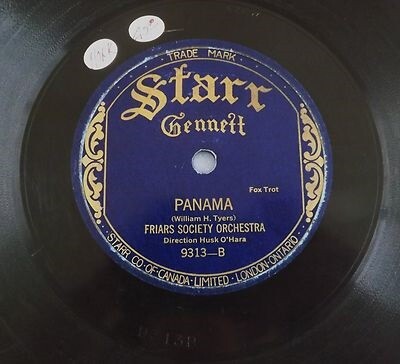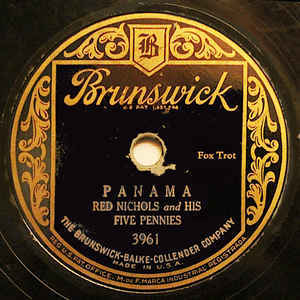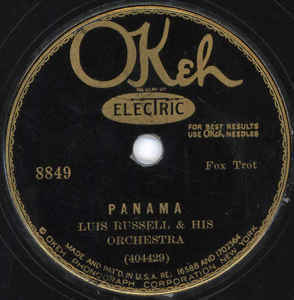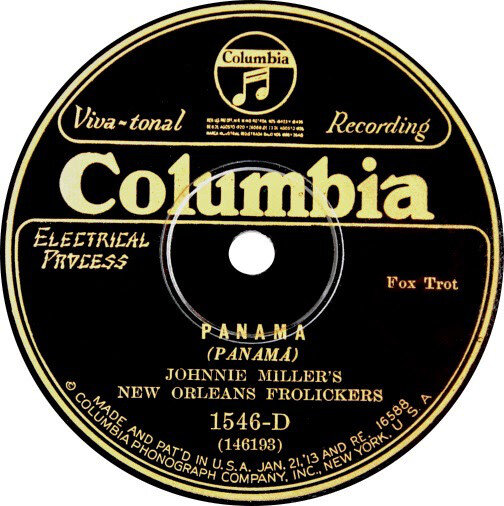 Hal Smith: Jeff, when you think about the traditional jazz “warhorses”—like “At The Jazz Band Ball,” “That’s A Plenty” or “Fidgety Feet”—traditional jazz musicians usually don’t make too many variations on the order of the strains. But “Panama” is a whole different ball game! Starting with the first jazz recording of the song in 1922 by the New Orleans Rhythm Kings, there are barely any records with the same routine, number of parts, or solos in the same places. Tracing the song as published through its development as a jazz standard is like trying to assemble a particularly difficult jigsaw puzzle! As background to this discussion, can you say something about the composer, the original form of the song and the way it was intended to be played?
Hal Smith: Jeff, when you think about the traditional jazz “warhorses”—like “At The Jazz Band Ball,” “That’s A Plenty” or “Fidgety Feet”—traditional jazz musicians usually don’t make too many variations on the order of the strains. But “Panama” is a whole different ball game! Starting with the first jazz recording of the song in 1922 by the New Orleans Rhythm Kings, there are barely any records with the same routine, number of parts, or solos in the same places. Tracing the song as published through its development as a jazz standard is like trying to assemble a particularly difficult jigsaw puzzle! As background to this discussion, can you say something about the composer, the original form of the song and the way it was intended to be played?
Jeff Barnhart: I’d love to, Hal. “Panama” was originally a multi-strain piano solo by black musician, arranger and composer William H. Tyers, published in 1911. In form, it follows both marches and rags, but throughout it sports the habanera rhythm that Joplin utilized in his 1909 piece, “Solace.”
Tyers, born in Virginia in 1870, spent the bulk of his personal and professional life in the eastern US, primarily in NYC. Tyers was an accomplished musician in more demand for his arranging skills than his compositional abilities; no pieces he composed became mega-hits or “standards” of any genre in which he wrote. His arranging prowess, like that of his Midwestern counterpart Artie Matthews, helped bring many pieces by black composers to publication.
 To describe the form of “Panama,” I’ll label sections with letters (so, “A” for the first section, “B,” the second and so on). Hal, there are so many strains, let’s utilize this method throughout the column. The form of Tyers’ piece as originally published, with intros 4 bars in length and each lettered section 16 bars each, is: Intro (key of F); A (2x-F); B (2x-F); A (1x-F); C [Trio] (2x-Bb); D (2x- Bb); Intro Reprise (back to F); A (1x-F); Coda (8 bars-F). So, in shorthand, eliminating key changes: Intro-AA-BB-A-CC-DD-Intro-A-Coda.
To describe the form of “Panama,” I’ll label sections with letters (so, “A” for the first section, “B,” the second and so on). Hal, there are so many strains, let’s utilize this method throughout the column. The form of Tyers’ piece as originally published, with intros 4 bars in length and each lettered section 16 bars each, is: Intro (key of F); A (2x-F); B (2x-F); A (1x-F); C [Trio] (2x-Bb); D (2x- Bb); Intro Reprise (back to F); A (1x-F); Coda (8 bars-F). So, in shorthand, eliminating key changes: Intro-AA-BB-A-CC-DD-Intro-A-Coda.
Hal, perhaps our discussion will answer some questions I have:
1) How did this piano parlor piece become such a ubiquitous selection for hot jazz bands over the ages (from NORK 1922 that you mentioned to the present!)
2) How did the piece undergo so many variations in form and key?
3) WHERE did that other section (which we’ll call “E”) not in the original Tyers piece come from? Harmonically, precedents include the final section of “Maple Leaf Rag,” and the second section of Charles Johnson’s 1906 composition “Iola,” while we later find it in the first section of Bogalusa Strut and the tune “All the Girls Go Crazy,” but HOW did it find its way into “Panama?”
Before I hand the baton back to you for an overview of the NORK recording from 1922, I want to highlight the duo version of which you reminded me, available on YouTube, featuring pianists Butch Thompson and Jim Dapogny, during which they faithfully perform Tyers’ composition in habanera style (albeit in the keys of D and G!) from start to finish. Before they reprise the “intro-final A-coda” denouement, they each improvise some choruses on the final section (D), emulating their mutual hero Jelly Roll Morton all the way, perhaps giving us our first clue as to how a rather polite piece of parlor pianism became a raucous traditional jazz classic!
HS: Interestingly, Morton played “Panama” as a stomp—no “Spanish Tinge” at all—on both of his records of the song. We’ll save that for Part 2, but in the meantime…The first hot jazz recording of the piece was made by the New Orleans Rhythm Kings (a/k/a Friars Society Orchestra) in 1922. The routine they followed was: No intro; A (Eb-2x); D (Eb-1x); E [new section not in Tyers] (Eb-1x); E (clarinet solo); E (ens); D (Eb-2x)—2nd time, the barest outline of the descending climactic chorus. As far as I can tell, this was the first appearance of the “E” section. And I have no clue where it originated!
JB: The “E” section is also the section on which clarinetist Leon Roppolo takes the only solo chorus of the recording. AND the B and C sections are completely omitted. It would be magic to go back to NOLA between the years of 1911 and 1922 to see how this version evolved into existence. In shorthand, the NORK 1922 roadmap is: AA-D-E-E-E-D-D.
HS: In his book We Called It Music, Eddie Condon recalled playing “Panama” with Bix Beiderbecke in a jam session aboard a train! Since they had just heard the NORK the previous night—with Bix sitting in—you have to wonder if the jam session version of the song was similar to what the Rhythm Kings played!
JB: I imagine it most likely was, and that it was no doubt one of the hottest versions never heard by anyone but the participants!
HS: The following year, just when you might think that the next recording of “Panama” would be based on the NORK … W.C. Handy’s Orchestra made a record of it based on the original concept! Our good friend Colin Hancock alerted me to Handy’s version, which was played for the most part as a tango. The routine which Handy used is: Intro (F); A (F-1x); B (1x-F); A (1x-F); C (2x-Bb); D (1x-Bb in 4/4); Intro reprise; A (1x-F); Coda (8 bars-F). I am pretty sure that Handy’s recording is the last one that is based on the original sheet music until the Thompson-Dapogny version.
JB: I believe you’re right, at least that was widely released. Handy’s hard-swinging D section is such a contrast to what follows: the reprise of the intro and A section and then that haunting coda that Tyers included in the original piano solo. What a surprise to go from a martially genteel reading (is that possible? Here it seems to be!) to one chorus of toe-tapping hot jazz then back to the original style. I went back to listen to that one chorus several times! While Handy’s recording adheres very closely to Tyers’ vision, by the time NORK recorded Panama in Chicago in 1922, King Oliver had been up there for 4 years and no doubt was among the first to hear the recording. Any thoughts on that?
HS: New Orleans trumpeter Lee Collins recalled that when he replaced Louis Armstrong in King Oliver’s Creole Jazz Band, the first song they played was “Panama.” There’s another mystery for us: How did the Oliver band assemble the parts?!?
JB: A real loss that they never got around to recording that one! I’ll briefly touch on the version that inspired me to suggest this topic for us several months back: the 1924 New Orleans recording of cornetist Johnny DeDroit’s band. Having heard “Panama” from every band under the sun literally hundreds of times over the past 40 years, THIS one knocked me back on my heels! The form this time around is:
Intro-AA-BB-A-C-D (ens)-D (clarinet solo; piano plays melody)-D (final ensemble)
Several elements stand out: During the opening two ensembles (A), DeDroit plays the first four-bar melody 3x in a row, and then on the second “A” he essentially improvises a new coherent melody! The band extends the final chorus with a double ending (an addition of two bars) PLUS an EXTRA bar, resulting in a 19-bar final chorus! Lastly, the band plays this version in the keys of D and G (not standard keys at all, although in 1925, Fletcher Henderson uses the same keys and the same A melody as DeDroit here, so is this version from a stock orchestration of the time?). At any rate, DeDroit’s version is HOT!
HS: Henry Halstead’s Orchestra (from Oakland, California) also recorded the piece in 1924. On the record label, the song is described as a “shimmy one-step.” That’s about as far from a “characteristic novelty” as you can get! And their routine does not match any of the previous versions: Piano Intro—AA—DD—E—E (low-register clarinet solo and break)—E – D—E with breaks on all the E strains and a double ending. That “mystery strain” we mentioned earlier now seems be included in every recording!
The same year, comb-and-tissue paper virtuoso Red McKenzie recorded “Panama” with his “Candy Kids.” Their version is the most different to date (to say nothing of the instrumentation: comb, kazoo, guitar and banjo)! Guitarist Eddie Lang plays an improvised intro, then the quartet goes directly to the D strain, following with E—D—E—D—and three E strains out with a double ending. There are breaks along the way by kazoo, comb and guitar and a couple of rhythmic variations by the guitar and banjo. Definitely an unusual performance of “Panama!”
JB: You said it, brother! The start of the Halstead version features an exhilarating, if bizarre, novelty-piano intro and a STOMPING out chorus! The “Candy Kids” side is in Ab throughout…not the usual key for guitar and banjo (excepting of course it is Eddie Lang so NO limits!) and I honestly didn’t know comb and kazoo could navigate Ab (OK…I’m being facetious…Ha)!
Looking at the aforementioned 1925 version by Fletcher Henderson’s Dixie Stompers, the highlights for me were found in the three final choruses (all on the D strain): the first offers us the most complete rendering of the famous final chorus melody yet; the second has a lovely legato clarinet trio getting hot in the final 4 bars; the third features a free-for-all ensemble that had me leaping out of my seat!
HS: AND the Henderson record is the only version up to this point that includes all the strains! It is amazing to consider that just a couple years after the NORK recording, every band that recorded the piece used a different routine!
JB: We’ll see that again with two versions from 1928 that could not be farther apart stylistically, although both illustrate how far we have come from Tyers’ original piece from 1911. Johnny Miller’s New Orleans Frolickers’ performance, recorded in NOLA, begins with a NEW 4-bar intro based on the whole-tone scale until the wonderful tubist Chink Martin walks us up to the first strain. Sections B and C are again left out, so the form is: A (2x); D (1x); D (clarinetist Sidney Arodin solo); E (alto solo); E (banjo solo); E (cornetist Sharkey Bonano solo); E (ensemble); D (2x); then a NEW arranged horn ending. This version is set apart by a much looser feel than we’ve yet encountered, 2-bar solo breaks at the end of each section and finally the complete melody of the final chorus!
In contrast, Red Nichols and His Five Pennies begin their version with an intro of unusual duration (10-bars) consisting of a clarinet long-tone over a horn riff of incredible complexity. This is heady stuff indeed, although, like McKenzie’s version four years prior, this performance only includes the D and E themes. But who cares? How can you miss with a Miff Mole trombone solo, an unbelievably intricate, multi-tonal piano ride by novelty-demigod Arthur Schutt, a skipping alto solo by Jimmy Dorsey, the earthy wail of Fud Livingston’s clarinet, and tight, arranged ensemble work throughout! No long goodbyes here as the band stops on a dime at the end of the final chorus (yes, once again on our “mystery” section!).
HS: Don’t forget that marvelous drumming by Vic Berton! It’s understated, but how he moves the Five Pennies along with a lift and swing. And Fud Livingston sure did pay attention to Teschemacher!
JB: Indeed! We’re coming up to one of our very favorites, Hal. I’ll defer to you to begin our exploration of the 1930 outing by Luis Russell and his Orchestra.
HS: Where to start with this one?!? How about with the string bass? If this isn’t Pops Foster’s greatest record, it surely has to be one of his very best. To my ears, Pops dominates this 1930 performance, laying down a wonderful, hard-charging rhythm that never lets up. And his fellow New Orleanians—trumpeter Henry “Red” Allen, clarinetist Albert Nicholas and drummer Paul Barbarin are on fire all the way through this flag waver, inspiring non-New Orleanian trombonist J.C. Higginbotham and alto saxophonist Charlie Holmes with their Crescent City sounds!
I don’t think anyone would disagree that this is one of the hottest jazz records ever made! And they utilized yet another routine for the piece: Intro (original, with horn riffs); D (Eb ens); B (ens); 8 interlude (horn breaks, bass solo); C (Ab-horns choral melody behind tpt solo); D (Ab-trombone solo, saxes riff background); 4 bar interlude; D (Ab-tenor sax solo); D (ens, figures); 2 bar trombone break; D (ens. Famous last chorus); D (clt solo); D (alto solo, horns riffing); D (free-for-all ens.); double ending. I shake my head in wonderment every time I listen to this one. We will talk about a couple more recordings of “Panama” featuring New Orleans musicians, but before we do that…Jeff, do you have anything to add regarding the Luis Russell record?
 JB: Only that this record is a lesson in how to start on high-heat and let ‘er boil, NEVER letting up! Every solo is backed by inventive horn riffs; and the legato melody of the C strain is almost tenderly underneath Red Allen’s torrid solo! The magical combination of expert arranging and edge-of-the-seat playing makes this band sound like much more than nine musicians. You’ve got to listen to this version half-a-dozen times to catch most of what is happening; just this past week I’ve listened to it two dozen times and still find something new on every go round. Whew!! Here, strains B and C make a welcome return, while A and the “mystery” E sections are missing. Either pianist/bandleader Russell had a familiarity with the original sheet music, or he had taken notice of Fletch’s version from five years prior.
JB: Only that this record is a lesson in how to start on high-heat and let ‘er boil, NEVER letting up! Every solo is backed by inventive horn riffs; and the legato melody of the C strain is almost tenderly underneath Red Allen’s torrid solo! The magical combination of expert arranging and edge-of-the-seat playing makes this band sound like much more than nine musicians. You’ve got to listen to this version half-a-dozen times to catch most of what is happening; just this past week I’ve listened to it two dozen times and still find something new on every go round. Whew!! Here, strains B and C make a welcome return, while A and the “mystery” E sections are missing. Either pianist/bandleader Russell had a familiarity with the original sheet music, or he had taken notice of Fletch’s version from five years prior.
Seems we keep coming back to the NORK, this time to discuss the 1934 version helmed by sideman trumpeter Wingy Manone. Hal, we’ve discussed discrepancies regarding personnel here, with the ONLY constant being Wingy! HA! What immediately strikes the listener is how much playing styles had changed in 12 years. The instrumentation is classic Chicago style with a four horn front line (clarinet/tenor are the 2 reeds) and everyone is so loose while keeping it hot. This is the first time we hear more ensemble at the front of the tune than at the end as well. Hal, I’m going to go out on a limb and declare it sure sounds like Ray Bauduc on drums to me!
HS: The 1934 version of the NORK sounds like one of Wingy’s own bands (and we’ll discuss that in just a minute). I’m not entirely sure of the personnel as listed in Brian Rust. The trombone sounds too laid-back to be George Brunies. Sidney Arodin on clarinet and Eddie Miller on tenor sax—definitely. I’m not familiar enough with pianist Terry Shand or bassist Benny Pottle to comment, but am going to disagree with you on the drummer. To my ears, the playing doesn’t sound loose enough to be Ray Bauduc. The discography lists “Bob White,” but it sounds like Sammy Weiss to me! In any case, here is yet another variation on the routine: (No Intro); A (2x ens.), D (2x ens.), E (3x; clarinet, tenor sax, trombone solos), D (ens.), D (ens. out with extended ending).
JB: Regarding the routine, though the sounds have evolved, the roadmap is almost exactly that of the 1922 rendering. How about Wingy’s other version, Hal?
HS: Now, Wingy’s record, made two years later, has a completely different routine! It’s in Eb all the way, with no intro. Then: D (2x ens.), E (3x, 2 clarinet solos and one trumpet), D (2x, ens.), D (ens. with arranged ending). This one has lovely clarinet by Joe Marsala and a crackling trumpet chorus by J. Wingston, plus a quote from Louis Armstrong’s “Potato Head Blues.” While not as energetic and hot as some of the versions we have heard, it is still a good performance. What do you hear on this one, Jeff?
JB: This rendition has that loose shirtsleeves style you’d want to hear (and dance to) in a club! Nothing that makes you sit up straighter here, until Wingy lands on a high concert G and, while the other horns are chugging away, holds it throughout the final 8 bars of the penultimate chorus and into the final chorus, whereupon that note becomes the first note of the famous descending figure. And then they all go for the jugular! So simple, so brilliant, so beautiful.
Another version from 1936 finds us in the company of cornetist Jimmy McPartland leading Jimmy McPartland’s Squirrels (!?). Hal, besides George Wettling’s fabulous drumming and the presence of the redoubtable clarinetist Rosy McHargue and tubist Country Washburn (later of Spike Jones fame), what stands out to you?
HS: I like McPartland’s record a lot! The combination of tuba and guitar in the rhythm section is a nice sound, and including a tuba on a recording session in the middle of the Swing Era was a bold move. There is no intro; A (ens.), D (ens.), E (5x; solos by clarinet, cornet, tenor sax, trombone, piano), D (ensemble, straight out). There are some excellent jazzmen on this recording: besides those you mentioned above, there’s trombonist Joe Harris, tenor man Dick Clark, pianist Jack Gardner and Jimmy’s brother Dick on guitar. The “Squirrels” name was a result of the jam sessions led by McPartland at the Chicago home of jazz fan “Squirrel” Ashcraft.
 JB: Hal, to wrap up part 1, let’s briefly comment on the three big band versions we listened to: The Casa Loma Orch. (1934), Tommy Dorsey Orch. (1938) and Bob Crosby Orch (1939). “Panama” really doesn’t represent any of these bands at their best. It seems to me the inherent excitement in “Panama” doesn’t lend itself to the heavy arranging necessary to produce a cogent big band performance. Thoughts on this?
JB: Hal, to wrap up part 1, let’s briefly comment on the three big band versions we listened to: The Casa Loma Orch. (1934), Tommy Dorsey Orch. (1938) and Bob Crosby Orch (1939). “Panama” really doesn’t represent any of these bands at their best. It seems to me the inherent excitement in “Panama” doesn’t lend itself to the heavy arranging necessary to produce a cogent big band performance. Thoughts on this?
HS: I wouldn’t expect a jazz classic from the Casa Loma band, but am a little surprised that the Dorsey and Crosby records aren’t a little bit hotter. However, there are some nice solos: clarinetist Johnny Mince and TD on the Dorsey record; tenor saxophonist Eddie Miller and trombonist Warren Smith on Crosby’s.
JB: What a ride it’s been so far! We’re going to begin part 2 next month with two performances by Jelly Roll Morton. Stay tuned and thanks for reading!
Hal Smith is an Arkansas-based drummer and writer. He leads the El Dorado Jazz Band and the
Mortonia Seven and works with a variety of jazz and swing bands. Visit him online at
halsmithmusic.com
Jeff Barnhart is an internationally renowned pianist, vocalist, arranger, bandleader, recording artist, ASCAP composer, educator and entertainer. Visit him online atwww.jeffbarnhart.com. Email: Mysticrag@aol.com























